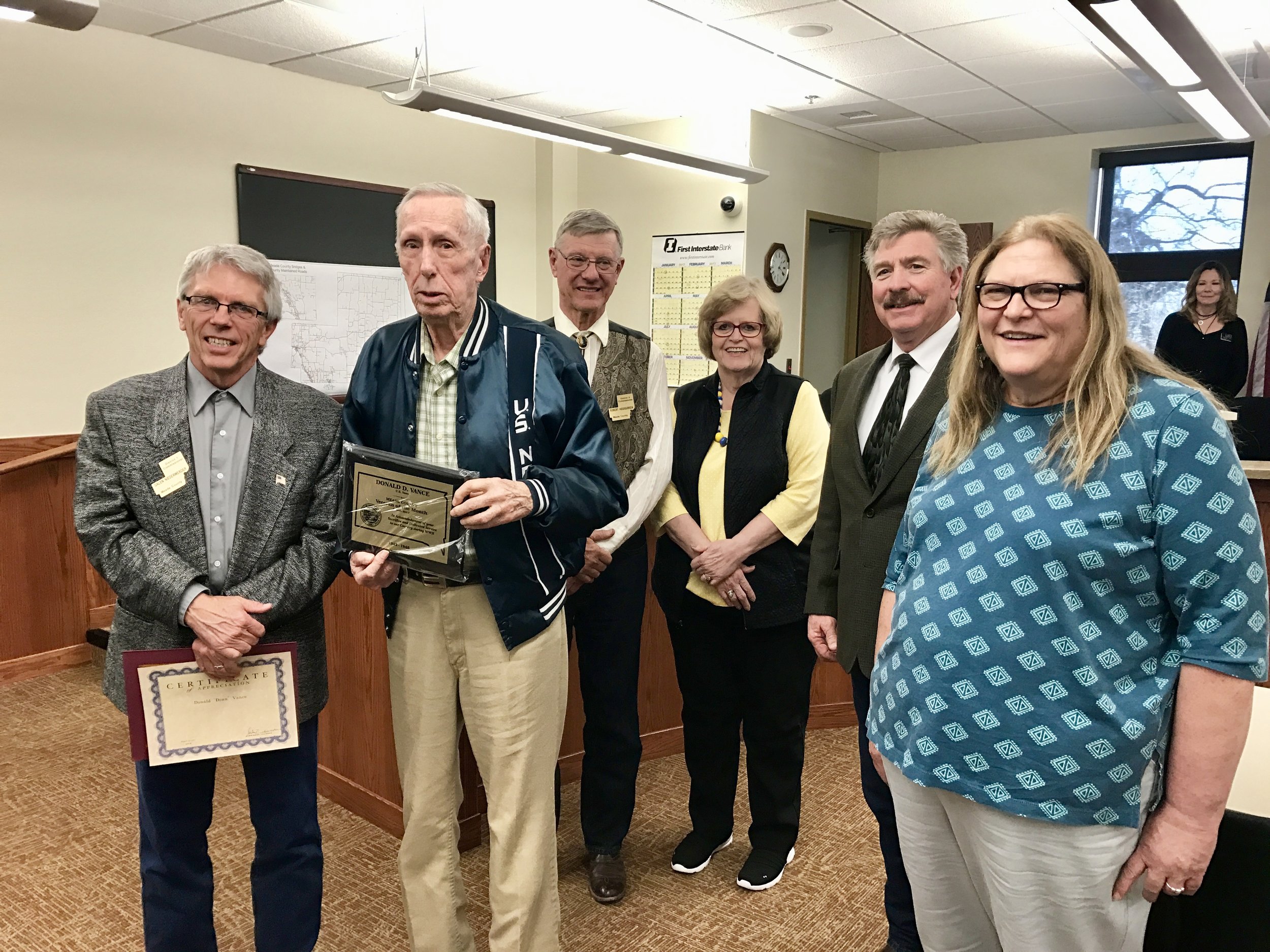County road issues
Spring has caused problems for drivers on some county roads. It was a long, hard winter and the early spring rains took a toll. Roads with the greatest problems were re-graveled last fall, just built or have heavy truck traffic.
Highway superintendent Lincoln Shuck has instituted multiple testings of gravel to insure proper mix of rock and clay. He also added a new water test. Not all material has reacted the same with moisture. The goal is diminishing a slick surface, yet have grip and ultimately a smooth driving surface.
The Meade highway department members are slated to lay 160,000 tons of gravel this spring. The maintenance gravel will come from the Bruch, Hwy 79 Pit, Bestgen and Baker pits.
Road crews have been grading for a temporary fix on roads. When the blown-out roads dry, the department is going to pull up the road surface to get the gravel up; mix it, and relay it. If additional gravel is needed, it will be added. Some road reshaping will be done.
Major work on High Meadows Road has just been completed and guard rails installed.
Bids were let to build a nearly $1 million Weyrich bridge off Highway 34.
The dangerous Elm Springs Road, near the Anderson place, is being reshaped and the hill cut. That bid was approximately $100,000.
The commission reviewed engineer cost estimates on the Elk Creek/Elk Vale road project which is estimated to cost $6.5 million. Some of it can be done in stages. Naturally with a project estimated to cost about 40 percent of Meade’s annual budget, it takes planning. One option is to finance part through the state STP program. In return the county will not receive any more of those funds for seven years. Specifics are being explored and the highway department is getting rights-of-way secured. Adjacent landowners have the option to donate their ROW.
Truck traffic is tearing up Fort Meade Way and Pleasant Valley roads. The commissioners may likely adopt its first-ever gravel road weight limit. Officials are gathering specifics and it is on Wednesday’s commission morning agenda. Once a road is posted, the Highway, Patrol can cite overweight trucks.
Also on Wednesday’s agenda is further discussion on roads that may be mag watered. The rate for county-applied mag water for private individuals was set at $1 a linear foot. This is below cost but slightly higher than the current fee.
County residents can be assured the dedicated highway department members are going to have another busy year doing their utmost to keep the county’s nearly 1,000 miles in shape.
Non-ag assessments
Two days this month were dedicated to hearing a couple dozen appeals about the assessor’s office property assessments. There is approximately $2.4 billion in Meade County taxable evaluations. Agricultural land, non-ag property and owner occupied (houses) assessment categories each comprised about one-third of the county’s valuation.
Major complaints in this category were:
Three liquor licenses holders wanted ag status. Ag property is not only valued at a lower rate, the resulting tax is much lower because approximately two-thirds of all tax dollars go to finance schools. The mill levy is also substantially lower on ag property.
The Meade Commission had determined properties with liquor licenses be assessed as non-ag.
Glencoe Campground owner Deborah Lopez contended its cattle grazing lease and size merited the ultimate much lower tax bill. The commission did not concur.
Sturgis Attorney Mike Strain represented Mike Ballad’s request for ag status on the Pappy Hoel Campground (formerly known as the Broken Spoke). He also questioned the assessment of buildings under construction. There was an adjustment to the value of 100 acres in a drainage ditch along highway 79. The area remained primarily non-ag status.
Attorney Rod Woodruff purchased the Lazy H ranch for approximately $1 million. He contends it remains a profitable ag operation. He also owned a liquor license at Sacora Station he transferred to 320 acres of this property adjacent to Fort Meade Way. He told the commission he anticipated Piedmont annexation and wanted to protect this asset. He does not plan on selling liquor. In other words, he is parking this liquor license until it can be sold to another entity. He was not successful in his plea.
Rapid City attorney Kent Hagg requested ag status for Elk Creek Properties. This southern Meade County residential development currently has 44 platted lots plus un-platted acreage assessed at $2 million. The corporation was awarded a multi-million TIF district a couple of years ago to offset infrastructure development costs. Hagg said a non-ag status puts too much of a financial hardship on the corporation prior to lot sales. The commission believed the TIF status separated this development from others.
In a semi-related matter, Hagg was at the regular commission meeting requesting a variance to Ordinance 20’s requirement for curb and gutter. He favored the lower cost option of culverts and ditches. A graduate student from the School of Mines gave his view that using vegetated ditches is a much sounder environmental solution and slows runoff.
On a split vote, the commission demanded curb and gutter, a hydrology study, and highway department review of the Elk Creek box culvert water crossing, before final plat approval.
Two Texas attorneys disputed the Hunt Housing assessment of 828 houses built on federal property at Ellsworth Air Force Base. This corporation has taken its assessments since 2011 to circuit court. A judge ruled approximately $15 million was more appropriate. The county disagreed. Further court proceedings are progressing. The county’s assessment this year was $28 million; Hunt requested $12 million. The commissioners did not concur.
Agricultural assessments
There has been some vocal unrest in the agricultural community since the S.D. Department of Revenue demanded in 2013 that Meade County increase the valuations on two million acres of ag land for the first time since 1993. The across the board increase that year was 25 percent. In a single year, it raised the average acre assessment from $178 in 2012 to $217.
South Dakota ag land is assessed on productivity. SDSU's Economics Department produces the “productivity value” for the valuation system. The productivity value formula multiplies the gross revenue by the landlord share percentages, then divides this amount by the cap rate: (gross revenue x landlord share percentage) / (cap rate).
The values the state sent Meade County for 2017 assessment pegged top dollar crop land value at $1,196; average cropland at $938; and determined the average Olympic average income (2007-2014) per acre at $176.92. Top dollar for grassland was set at $458; average county grassland value at $141 an acre; and average rent listed at $9.35 an acre.
The Department of Revenue said when applying the values to each sub-set, the total county average per acre assessment should be $393. In reality, the Meade County Assessor’s Office reached an average of $348 per acre down from $354 from last year.
Kirk Chaffee. director of equalization, ordered an across the board 10 percent reduction in ag assessments due to the drought.
In the ensuing years, the SDDOR continued to demand increases in the 10 percent range.
This has raised the ire of Pat Trask and his daughter, Julie Trask, from Elm Springs. They along with attorney Lance Russell of Hot Springs, who is a member of the S.D. Senate, argued assessments need to be moved back to the 2012 level. They contend the state cannot force counties to follow its directives.
There is a lawsuit on this matter making its way through the court system.
The Elm Springs Township board appealed all land within the township including property not appealed by its out-of-state landowners. On the advice of its county legal counsel, the commissioners refused to act on property not directly appealed by its owners.
Earlier in the day, when ag producers identified an error in land terrain etc., the board made adjustments.
The Trasks said they were not interested in examining each parcel, they wanted to concentrate on the method of assessment and the state’s interference.
Landowner Jon Jordan, who has filed a lawsuit against the county, brought forward data he maintains is more accurate than that compiled by the state. He said the state’s data is based on faulty information, ag income figures are greatly inflated, thus, the average assessment levels are inaccurate.
















